Related Research Articles
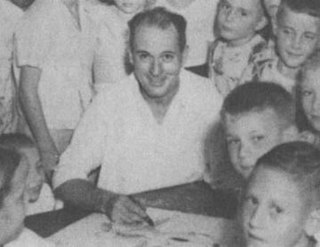
Charles Alfred "Al" Taliaferro, was an American Disney comics artist who produced Disney comic strips for King Features Syndicate. Taliaferro is best known for his work on the Donald Duck comic strip. Many of his strips were written by Bob Karp.

Theodore H. Osborne was an American writer of comics, radio shows and animated films, remembered for his contributions to the creation and refinement, during the 1930s, of Walt Disney cartoon characters.
Silly Symphony is an American animated series of 75 musical short films produced by Walt Disney Productions from 1929 to 1939. As the series name implies, the Silly Symphonies were originally intended as whimsical accompaniments to pieces of music. As such, the films usually did not feature continuing characters, unlike the Mickey Mouse shorts produced by Disney at the same time. The series is notable for its innovation with Technicolor and the multiplane motion picture camera, as well as its introduction of the character Donald Duck making his first appearance in the Silly Symphony cartoon The Wise Little Hen in 1934. Seven shorts won the Academy Award for Best Animated Short Film.
Disney comics are comic books and comic strips featuring characters created by the Walt Disney Company, including Mickey Mouse, Donald Duck and Scrooge McDuck.
Bucky Bug is a beetle who appears in Disney comics. He first appeared in the Silly Symphony Sunday comic strip, and later appeared as a regular feature in the comic book Walt Disney's Comics and Stories.
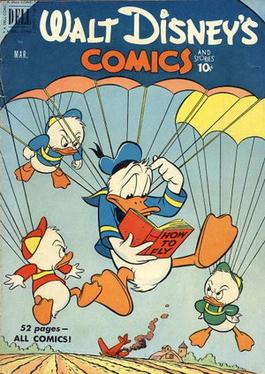
Walt Disney's Comics and Stories, sometimes abbreviated WDC&S, is an American anthology comic book series featuring characters from The Walt Disney Company's films and shorts, including Donald Duck, Scrooge McDuck, Mickey Mouse, Chip 'n Dale, Li'l Bad Wolf, Scamp, Bucky Bug, Grandma Duck, Brer Rabbit, Winnie the Pooh, and others. With more than 700 issues, Walt Disney's Comics & Stories is the longest-running Disney comic book in the United States, making it the flagship title, and is one of the best-selling comic books of all time.
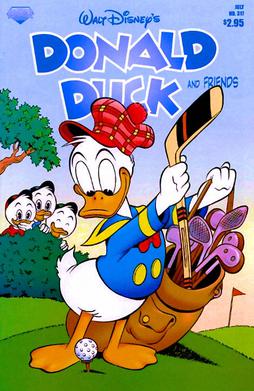
Donald Duck, also known as Donald Duck and Friends, is an American Disney comic book series starring the character Donald Duck and published by various publishers from October 1942 to June 2017. As with many early Disney comics titles, Donald Duck began as individual issues of Dell Comics' Four Color one-shots series. It was published as its own regular series in November 1952, starting with issue #26.
Merrill De Maris was an American writer who worked on Disney comic strips for King Features Syndicate.
Paul Murry was an American cartoonist and comics artist. He is best known for his Disney comics, which appeared in Dell Comics and Gold Key Comics from 1946 to 1984, particularly the Mickey Mouse and Goofy three-part adventure stories in Walt Disney's Comics and Stories.
Owen Earl Duvall was an American artist and animator best known for his work on Disney comic strips in the early 1930s and for a handful of animated short films he directed at Warner Bros. Cartoons.
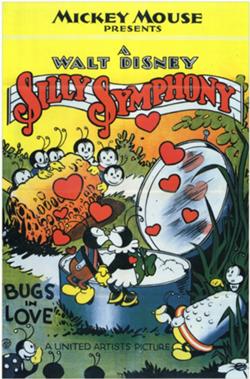
Bugs in Love is a Silly Symphonies animated Disney short film. It was released in 1932, and was the final Symphony to be shot with black-and-white film.

Silly Symphonies: The Complete Disney Classics is a book series which reprints Walt Disney's Silly Symphony Sunday comic strip, drawn by several different Disney artists from 1932 to 1945. The strip was published by King Features Syndicate. The strip often introduced new Disney characters to the public, including its first comic character, Bucky Bug. The series was published by The Library of American Comics from 2016 to 2019.
Donald Duck: The Complete Sunday Comics is a series of hardcover books collecting the complete run of Disney's Donald Duck Sunday newspaper comic strip. Drawn by the American comic artist Al Taliaferro, it starts off with the first of Donald Duck's own Sunday strip page from 10 December 1939, after he had first been introduced in the successful Silly Symphony Sunday strip feature as well as in his own daily newspaper strip since 1938. The publisher behind the project is IDW Publishing and their imprint (subdivision), The Library of American Comics. The first book of the series was released in March 2016.
Donald Duck: The Complete Daily Newspaper Comics is a series of hardcover books collecting the complete run of the Disney Donald Duck comic strip, a daily newspaper comic strip drawn by the American comic artist Al Taliaferro. The comic strip debuted on February 7, 1938, and within eight weeks became the fastest growing syndicated comic strip worldwide. The publisher behind the project is IDW Publishing and their imprint, The Library of American Comics. The first book of the series was released on September 2, 2015.
Walt Disney's Treasury of Classic Tales is a series of hardcover books that collects the Sunday comic strips of Walt Disney's Treasury of Classic Tales, an umbrella title for comic strips which were drawn by several different Disney artists during the period of the early 1950s to the mid-1980s. The Treasury of Classic Tales comic strips were used by Walt Disney Studios to introduce current movie characters into comic adaptations for the public. The books are being published by IDW Publishing's imprint, The Library of American Comics. The first book of the series was released in November 2016.
Donald Duck is an American comic strip by the Walt Disney Company starring Donald Duck, distributed by King Features Syndicate. The first daily Donald Duck strip debuted in American newspapers on February 7, 1938. On December 10, 1939, the strip expanded to a Sunday page as well. Writer Bob Karp and artist Al Taliaferro worked together on the strip for more than 30 years. The strip ended in May 1995.
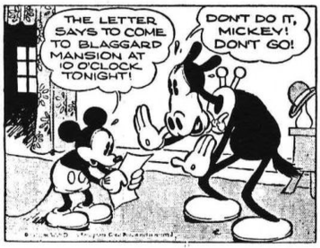
Mickey Mouse is an American newspaper comic strip by the Walt Disney Company featuring Mickey Mouse and is the first published example of Disney comics. The strip debuted on January 13, 1930, and ran until July 29, 1995. It was syndicated by King Features Syndicate.

Mickey Mouse Magazine is an American Disney comics publication that preceded the popular 1940 anthology comic book Walt Disney's Comics and Stories. There were three versions of the title – two promotional giveaway magazines published from 1933 to 1935, and a newsstand magazine published from 1935 to 1940. The publication gradually evolved from a 16-page booklet of illustrated text stories and single-page comic panels into a 64-page comic book featuring reprints of the Mickey Mouse and Donald Duck comic strips.
Uncle Remus and His Tales of Br'er Rabbit is an American Disney comic strip that ran on Sundays from October 14, 1945, to December 31, 1972. It first appeared as a topper strip for the Mickey Mouse Sunday page, but after the first few years, almost always appeared on its own. The strip replaced the 1932-1945 Silly Symphony strip, which had spent its final year on gag strips featuring Panchito from The Three Caballeros.
Walt Disney's Silly Symphonies is a series of books collecting Disney's Silly Symphony Sunday comic strip. Following a previous collection by IDW Publishing, this project is published by Fantagraphics Books under the supervision of David Gerstein. The first book of the series was released in April 2023.
References
- 1 2 3 4 Holtz, Allan (2012). American Newspaper Comics: An Encyclopedic Reference Guide. Ann Arbor: The University of Michigan Press. p. 351. ISBN 9780472117567.
- ↑ Merritt, Russell; Kaufman, J. B. (2016). Walt Disney's Silly Symphonies: A Companion to the Classic Cartoon Series (2nd ed.). Glendale, CA: Disney Editions. ISBN 978-1-4847-5132-9.
- ↑ Bucky Bug
- 1 2 3 4 Duvall, Earl; Taliaferro, Al; Osborne, Ted; De Maris, Merrill (2016). Silly Symphonies: The Complete Disney Classics, vol 1. San Diego: IDW Publishing. ISBN 978-1631405587.
- 1 2 3 4 5 6 7 Becattini, Alberto (2019). "Disney Beyond Mickey". American Funny Animal Comics in the 20th Century: Volume One. Seattle, WA: Theme Park Press. ISBN 978-1683901860.
- ↑ Kinney, Jack (1989). Walt Disney & Assorted Other Characters: An Unauthorized Account of the Early Years at Disney's. Harmony Books. p. 75. ISBN 978-0517570579.
- ↑ Becattini, Alberto (2016). Disney Comics: The Whole Story. Theme Park Press. p. 17. ISBN 978-1683900177.
- ↑ Taliaferro, Al; Osborne, Ted; De Maris, Merrill (2016). Silly Symphonies: The Complete Disney Classics, vol 2. San Diego: IDW Publishing. ISBN 978-1631408045.
- ↑ Knudde, Kjell (1994). "Al Taliaferro". Lambiek Comiclopedia. Retrieved December 9, 2018.
- ↑ Kaufman, J.B. (2016). "Introduction". Silly Symphonies: The Complete Disney Classics, vol 2. San Diego: IDW Publishing. pp. 7–8. ISBN 978-1631408045.
- ↑ "Michael Sporn Animation – Splog » Snow White – the original strip". michaelspornanimation.com. Retrieved 2014-08-06.
- 1 2 Karp, Hubie; Grant, Bob; De Maris, Merrill; Taliaferro, Al; Porter, Hank (2018). Silly Symphonies: The Complete Disney Classics, vol 3. San Diego: IDW Publishing. ISBN 978-1631409882.
- 1 2 Horn, Maurice (1996). 100 Years of American Newspaper Comics: An Illustrated Encyclopedia. New York: Random House. ISBN 0-517-12447-5.
- 1 2 3 4 Becattini, Alberto (2016). Disney Comics: The Whole Story. Theme Park Press. p. 19. ISBN 978-1683900177.
- ↑ Holtz, Allan (2012). American Newspaper Comics: An Encyclopedic Reference Guide. Ann Arbor: The University of Michigan Press. p. 400. ISBN 9780472117567.
- ↑ Markstein, Don. "Br'er Rabbit". Don Markstein's Toonopedia. Archived from the original on September 1, 2015. Retrieved January 18, 2007.
- ↑ "The Black Hole: How Deep Is it?" by David E. Jefferson. The Collected Jack Kirby Collector v.2. p.96 Raleigh, NC: TwoMorrows Publishing, 2004. "... Disney used their Treasury of Classics Sunday comics strip as a vehicle to promote new films..."
- ↑ Holtz, Allan (2012). American Newspaper Comics: An Encyclopedic Reference Guide. Ann Arbor: The University of Michigan Press. pp. 393–394. ISBN 9780472117567.
- ↑ "Walt Disney's Comics and Stories #12". Inducks . Retrieved 22 July 2019.
- ↑ "Walt Disney's Comics and Stories #14". Inducks . Retrieved 22 July 2019.
- ↑ "Walt Disney's Comics and Stories #15". Inducks . Retrieved 22 July 2019.
- ↑ "Walt Disney's Comics and Stories #20". Inducks . Retrieved 22 July 2019.
- ↑ "Walt Disney's Comics and Stories #39". Inducks . Retrieved 26 July 2019.
- ↑ "Bucky Bug: The Playground Plot". Inducks . Retrieved 26 July 2019.
- ↑ "Walt Disney's Comics and Stories #78". Inducks . Retrieved 26 July 2019.
- ↑ "Silly Symphonies #6". Inducks . Retrieved 26 July 2019.